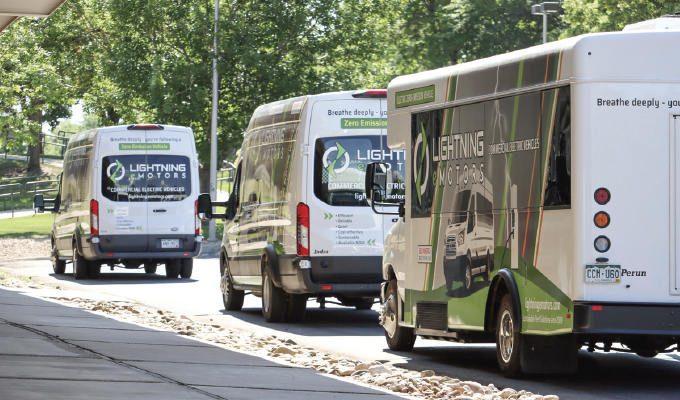Last month we introduced you to Lightning eMotors, the company that provides electric vehicle (EV) solutions for work truck fleets of all shapes and sizes. At its Lightning Day event, attendees experienced a ride and drive of its EVs, a facility tour, and sat in on a panel discussion Q&A, “The Electrification Equation,” sharing insights about the challenges of fleet electrification and how to combat them.
In part 1, we shared the first two steps a fleet owner should take when considering converting their fleet to electric. A panelist on The Electrification Equation panel, Brody Ayers of Xcel Energy, a utility company in Colorado, suggested focusing on charging infrastructure first. After all, an electric vehicle is useless without the chargers to power it. For this reason, Ayers says the first organization to talk to about EV conversion is the fleet’s utility company.
Another panelist, Gary Van Orden of Mike Albert Fleet Solutions, spoke on acquiring the electric vehicles. A fleet isn’t confined to acquiring a vehicle by buying it outright. Van Orden suggests talking to a leasing company. His company, Mike Albert Fleet Solutions, for example, helps fleets procure EVs in a few different ways.
THE FINAL STEP
Now that you’ve talked to your utility company, are in the process of building your charging infrastructure, and your electric vehicles are ordered, you’d think you’re all set, right? Brandon McNeil, vice president of energy and insights for Lightning eMotors would disagree. The third and final step of EV conversion is implementing EV-specific telematics software to optimize business operations.
“When looking at electrifying your fleet, software becomes a critical piece of electrification,” McNeil states. With EV-specific software, a simple program can determine the right vehicle with the right battery and the right charger to determine a pairing that makes operations most efficient. Additionally, McNeil says there are certain EV aspects that simply aren’t there with internal combustion engine vehicles. Therefore, an EV-specific telematics system can even help train drivers on behaviors that increase EV range.
Finally, an EV-specific telematics system can even help fleet owners save money through charging management. Charging management, such as ensuring vehicles are charged at off-peak times, stacking charging when possible, etc., puts vehicle “fueling” in the hands of the fleet owner/operator. No longer will EV fleet owners be at the mercy of their neighborhood gas station, but instead, with depot charging and charging management, fleets can take advantage of the lowest price of electricity rates and avoid demand charges.
MAINTAINING EVs
We said EV-specific telematics was the final step, but after you’ve employed EVs in your fleet for some time, you need to know how to maintain them. Ben Schroder, senior service manager for Lightning eMotors, says there are multiple maintenance options with EVs. Lightning eMotors can help train fleet technicians, leverage service partners across the US, help train a fleet’s current service providers, or even, if necessary, Lightning eMotors will come directly to the fleet, conduct a FaceTime call, phone call, etc.
CHARGING FORWARD
If you’re curious about converting your fleet, taking the advice from Lightning Day’s “The Electrification Equation” panel is a good place to start.
Find out more about Lightning eMotors, visit www.lightningemotors.com.




